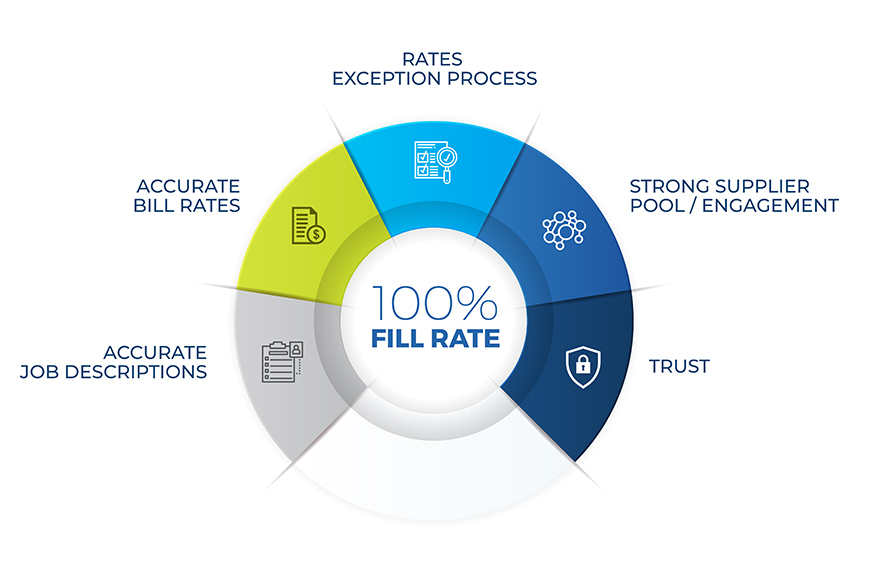The short answer is: 100%. Always. Forever.
You may think that’s unrealistic. Perhaps it even feels like a marketing pitch. But it isn’t. It’s completely realistic if you make the commitment. That’s because 100% fill rates aren’t about perfection, they are about adhering to a process – a process in which failure is never an option.
Five critical elements are required to hit 100% fill ratios – in any skill set, for any program, and in any type of economy.
Accurate Job Descriptions
Many programs still have generic job titles like “software developer,” “architect,” “consultant,” etc. This lack of specificity makes it harder to find the best candidates. Even when the underlying job description is accurate, the associated bill rate may not be. It is therefore important to disaggregate both job titles and bill rates into their relevant skill and experience tiers to support robust and accurate candidate sourcing. Hiring manager “intake” sessions (like verbal discussions with the MSP to confirm the primary needs or goals for a position) can facilitate this, especially for less common, harder-to-fill positions.
Accurate Bill Rates
The only way to achieve accurate bill rates is a precise and disaggregated set of job titles, coupled with deep market knowledge. For example, a position for a “software engineer” listed at $80/hr may actually be a “Senior J2EE Architect with Cloud Experience,” that requires 10-12 years’ experience, various complementary technologies, and is probably located in a Tier 1 city (meaning there is a higher cost of living). So that particular position may require a bill rate of $90-95/hr to be filled by a quality candidate, whereas lower bill rates may cause the position to go unfilled for months.
Rate Exceptions Process
An effective bill rate exceptions process must exist for candidates with unique skill sets, in difficult geographies, and potentially for other issues. For example, an SAP architect with secret clearance may be extremely hard to fill in a small city such as Lincoln, NE, and may require a rate increase to source quickly — or at all. Accordingly, a bill rate exceptions process to identify these types of unique circumstances must exist and have client buy-in. Typically, bill rate exceptions should not exceed 5% to 10% of total hires. If they do, your rate card probably needs to be reviewed.
Strong, Engaged Supplier Pool
In the search for savings, buyers have been rationalizing supplier pools for the past two decades—in many cases allowing a single supplier to recruit up to 80% of their programs. In many cases, supplier pools are overly rationalized – i.e., dependent on too few suppliers. In other cases, supplier pools are voluminous, resulting in under-engagement – i.e., suppliers responding slowly, ineffectively, or not at all to new positions due to the low likelihood of ever being rewarded. Both of these dynamics lead to ineffective sourcing and jobs left unfilled. It is the MSP’s responsibility to ensure a robust, high performing, fully engaged pool of capable suppliers across all geographies and skill sets.
Trust
The “speed of trust” has become almost a cliché these days, but it’s importance cannot be understated. Fundamentally, it is the MSP’s consistency and effectiveness that builds the necessary level of trust with each client over time. When that trust is in place, fill ratios of 100% are not only possible, but expected. However, once trust is lost, it is hard to gain back.
The reality is that the level-of-effort required to achieve 100% fill ratios requires a fully committed team coupled with a highly involved group of executives – both for the client and for the MSP. Programs cannot achieve 100% fill ratios on auto-pilot. They require rigorous reviews of metrics, work streams, and potential barriers to success. Much like diet and exercise, high-performing MSP programs require a change in lifestyle, not just a quick one-month fix or a few tweaks around the edges.
Read our other blogs about Dynamic Tiering in MSP here or here. And make sure to follow Pinnacle on Twitter, Facebook, and LinkedIn to stay up-to-date on our latest posts.

